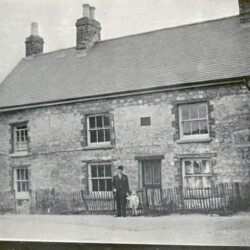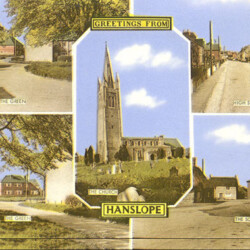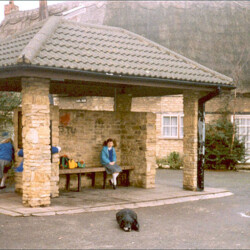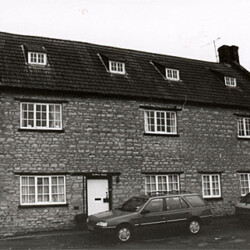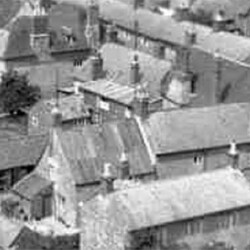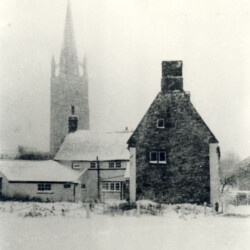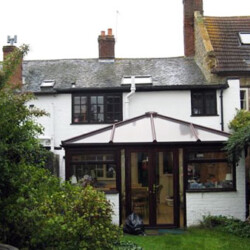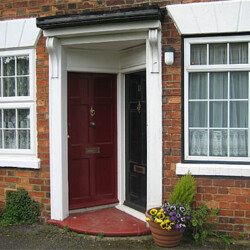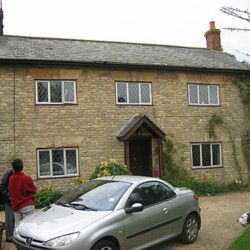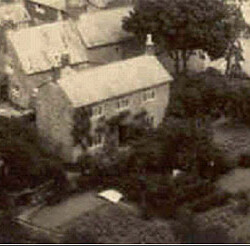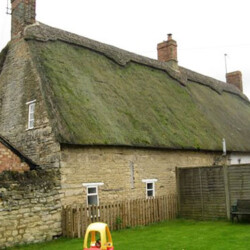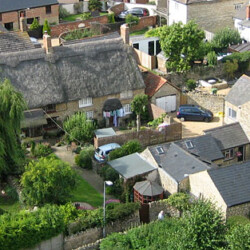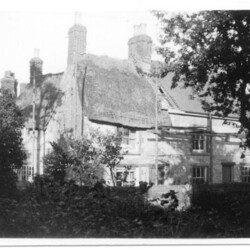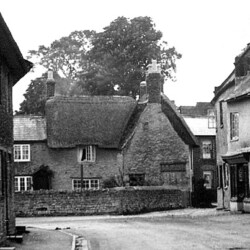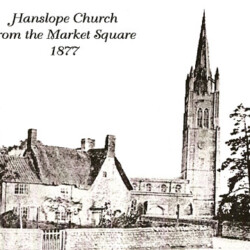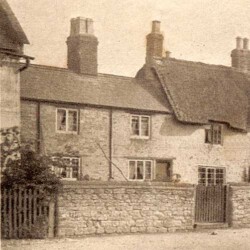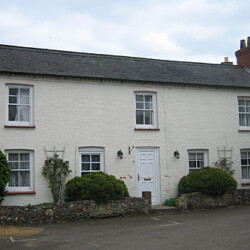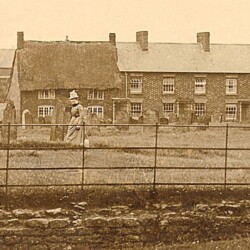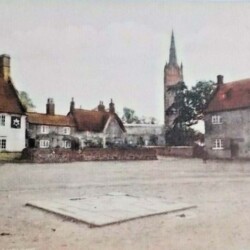
The Market Square, the Green Man and the old village pump. In the background is the Gospel chapel.
The cottages next to the Green Man were demolished in the 1930s. The building is now a private house.

Market Square from the church tower c.1930
The view includes the cottages in Fish Street, now gone, and Buckingham Terrace can be seen at the back of The Black Bull. Source: HDHS archive

Osbourne Cottages, off Market Square, c.2006
Osbourne Cottages on the left; the right side is the east end of Barnwell Buildings.

The Jolly family in Earl Row, off Market Square, c.1950
Jack and Nellie Jolly with daughters Rosemary and Tina
HDHS archive

Barnwell Buildings viewed from the church tower.
The roof of the thatched cottage that stood between the working mens club,and the bakehouse can be seen.

Hanslope women on way to Chapel in Gold St.
c1980
Rose Clare, Lottie Hawkes, Ella Mills, Millie Wells, Mrs Jones
HDHS archive

Yew Tree Cottages sale 1900
The cottages are not shown on the 1900 Ordinance Survey map, however they appear to have been included at the time of the 1901 census by the list of people identified with the building.
Source HDHS archive

Stafford House, Market Square, on the left of the photo, 2006
Taken by Robert Dymond.
Source HDHS archive

Jemima Greenwood's shop, Market Square
This shop stood at the junction of Market Square and Gold Street. It was built on land belonging to the Green Man and run by Jemima Courtman Greenwood whose husband ran the Green Man. The background sign reads Swan Inn
Photo from Moira Courtman in 1998

Horseshoe Cottages in the 1920s or 30s
Looking across Market Square
This building formed three cottages in 1900.
Source HDHS archive

Horseshoe Cottages 2006, ground floor windows being replaced, 2006
photo taken by Robert Dymond
Source HDHS archive

The Green Man 2006, formerly a pub, now a private house.
Photo taken by Robert Dymond April 2006.
HDHS archive

The Green Man 1950s
This photo is believed to have been taken after the pub closed in 1956. The cottages to the left of the pub had been demolished by this time.
The unusual feature was a chimney window which came down from the room above. This section of the chimney had to be swept from the window.

The Green Man c.1910
photograph showing the buildings to the west of the Green Man c.1910
HDHS archive

The Green Man, 1890
This is believed to be the earliest photo of the Green Man. It was supplied by a descendent of Henry Newbury, Inn Keeper, recorded in the 1861 to 1891 censuses.
HDHS archive

The Old Cobblers, 2006, previously known as Old Fairings.
Old Cobblers taken in April 2006 by Robert Diamond.
This building is next to Stafford House
Source HDHS archive

Church Row c2006
May 2006 Taken by Robert Diamond
The thatched building on the left was previously two homes.
Source HDHS archive

Church End early 1900s, Taken from the Church tower. This house formerly the Old Green Man public house.
Source HDHS archive

Maps of Church End and the Market Square
c1779-1990
maps show different footprint of buildings over time.
Source HDHS archive

12 Market Square and 1 Church End rear view
c.1970
Back of 12 Market Square and 1 Church End.
The wall to the right is believed to be the front wall of a house now removed between 10 market Square and The Green Man

10-12 Market Square
2006
In 1900 the building may have been three separate dwellings now it is one home.
April 2006 Taken by Robert Dymond .
Source HDHS archive

3 Church End c1950
These two cottages in Church End are now one .The couple on the right are Mavis and Norman Jubb. The solitary lady is Heather Sedgewick.
Source HDHS

1 Church End Magpies Nook
c 2006
The two windows on the left belong to 12 Market Square. The building set back is a modern extension

Market Square from the church tower c.1920
Some of the old houses no longer exist , one being the large house at the rear end of Caucutts Yard.
Source HDHS archive

St James the Great from the Market Square c. 1908.
The church dates from the 12th century. Its impressive tower, the highest in Buckinghamshire, was added in the 15th century when Hanslope was part of the estates of the Earls of Warwick. On the right of the photo is Stafford House, thought to be of medieval origin and named for Sir Robert and Lady Jane Stafford who were buried in the church in the 16th century. During the 18th-19th centuries it was a workhouse.
HDHS archive





